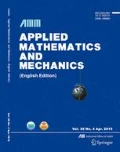Abstract
In this paper:
-
(A)
We cast aside the traditional quaternion theory and build up the theory of functions of a complex variable under Dirac-Pauli representation. Thus the multivariate and multidimensional problems become rather simple problems.
-
(B)
We simplify the Navier-Stokes equation of incompressible viscous fluid dynamics and the equations group of isentropic aerodynamics by theory of functions of a complex variable under Dirac-Pauli representation. And the above-equations, as central problems of fluid dynamics, are classified as the nonlinear equation with only one complex unknown function.
Similar content being viewed by others
References
Chien Wei-zang and Yeh Kai-yuan,Elasticity, Science Press, Beijing (1956). (in Chinese)
Shen Hui-chuan, Dynamical stress function tensor,Appl. Math. Mech. 3, 6 (1982), 899–904.
Shen Hui-chuan, Dynamical stress function tensor and several homogeneous solutions of elastostatics,J. China University of Science and Technology,14, Supplement 1, JCUST 84016 (1984), 95–102. (in Chinese)
Landau, L. D. and E. M. Lifshitz,Continuum Mechanics, National, Moscow (1954). (in Russian)
Prandtl, L., K. Oswatitsch and K. Wieghardt,Fuhrer durch die strömungslehre, Friedr, Vieweg+sohn, Braunschweig (1969).
Oswatitsch, K.,Gas Dynamics, Academic (1956).
Tsien Hsue-shen,Fundamentals of Gas Dynamics, (ed. by H. W. Emmons) Section A:Equations of Gas Dynamics. Oxford University (1958).
Taninti, T. and K. Nishihara,Nonlinear Waves, Pitman (1983).
Eckhaus, W. and A. van Harten,The Inverse Scattering Transformation and the Theory of Solitons and Introduction Mathematics Studies 50, North-Holland (1981).
Shen Hui-chuan, The relation of von kármán equation for elastic large deflection problem and Schrödinger equation for quantum eigenvalues problem.Appl. Math. Mech.,6, 8 (1985), 761.
Shen Hui-chuan, The Schrödinger equation of thin shell theories,Appl. Math. Mech. 6, 10 (1985), 887–900.
Hua Luo-gen,A first Course in Higher Mathematics,1, 1, Science Press, Beijing (1963), 20. (in Chinese)
Kurosh, A. G.,The Teaching Materiais in General Algebra, Phys. Math. National ed. Moscow (1962). (in Russian)
Kurosh, A. G.,A Course in Higher Algebra, National, Moscow (1950). (in Russian)
Wu Pin-san, Complex number, quaternion, biquaternion,Mathematical Bulletin, 8 (1964), 32. (in Chinese)
Baldaga, V. K.,The All Number, Capital University, (1959). (in Russian)
Hamilton, W. R.,Lectures on Quaternions, Dublin, Hodges and Smith (1853).
Hamilton, W. R.,Elements of Quaternions, Chelsea, N. Y. (1969).
Klein, F.,Elementary Mathematics from an Advanced Standpoint; Arithmetic, Algebra. Analysis, Tr. from the 3rd German ed. by E. R. Hedrick and A. Nöble, Dover. n. d., N. Y. (1924).
Wan Zhi-xian and Yang Jin-gen, Automorphisms of the quaternion unimofular group of two dimensions,Chinese Annals of Math.,2, 3 (1981), 387–397.
Wan Zhi-xian and Yang Jin-gen, Automorphisms of the projective quaternion unimodular group of two dimensions,Chinese Annals of Math. 3, 3 (1982), 395–402.
Branetz, V. N. and E. B. Shmouglevsky,Application of Quaternion in Orientation Problems of Rigid Body, Science, Moscow (1973). (in Russian)
Shen Hui-chuan, The fission of spectrum line of monochoromatic elastic wave,Appl. Math. Mech. 5, 4 (1984), 1509–1519.
Shen Hui-chuan, The solution of deflection of elastic thin plate by the joint action of dynamical lateral pressure, force in central surface and external field on the elastic base,Appl. Math. Mech. 5, 6 (1984), 1791–1801.
Shen Hui-chuan, On the general equations, double harmonic equation and eigen-equation in the problems of ldeal plasticity,Appl. Math. Mech.,7, 1 (1986).
Fung, Y. C.,A first Course in Continuum Mechanics, (2nd ed), Prentice-Hall, Inc. (1977).
Fykhkingolrtz, G. M.,Fundation of Mathematics Analyse, National, tech. theo. Moscow (1956–1957). (in Russian)
Dirac, P. A. M.,The Principle of Quantum Mechanics, Oxford (1958).
Flügge, S.,Practical Quantum Mechanics, Springer-Verlag (1974).
Claude, C-T. et al.,Quantum Mechanics,2 Tr. from French by S. R. Hemldy et al., Wiley, N. Y. (1977).
Duffin, R. J., On the characteristic matrices of covariant systems,Phys. Rev.,54, (1938), 1114.
Kemmer, N., The particle aspect of meson theory,Proc. Roy. Soc.,173 (1939), 91–116.
Kaluza, Th.,Sitzungsber d. Preuss, Akad. d. Wiss. (1921), 966; see P. G. Bergmann,Introduction to the Theory of Relativity, Prentice-Hall (1958).
Theodore von Kármán Anniversary Volume, Pasadena (1941), 212.
Synge, J. L. and Chien Wei-zang, The intrinsic theory of elastic shells and plates,Appl. Mech., Th. von Kármán Annivers Vol. (1941), 103–120.
Shen Hui-chuan, The general solution of peristaltic fluid dynamics,Nature Journal,7, 10 (1984), 799;7, 12 (1984), 940.
Boussinesq, J., Applications des potentiels á létnde de léquilibre et du mouvement des solides élastiques, Paris (1885).
Galerkin, B. G., To the general solution of solve a elasticity for three-dimension use stress and displacement functions, Report Acad. Scien. USSR, group A (1931), 281–286. (in Russian)
Babkovich, B. F., An introduction to some general solutions of fundamental differential equation for static isotropical elastic body,Appl. Math. Mech.,1, 1 (1937) 117–132 (in Russian)
Author information
Authors and Affiliations
Additional information
Communicated by Chien Wei-zang
So the changes are the Great Pole, and give birth to the, Two Bearings: the Two Bearings give birth to the Four Quadrants, and the Four Quadrants give birth to the Eight Diagrams.
Rights and permissions
About this article
Cite this article
Hui-chuan, S. The theory of functions of a complex variable under Dirac-Pauli representation and its application in fluid dynamics (I). Appl Math Mech 7, 391–411 (1986). https://doi.org/10.1007/BF01898228
Received:
Issue Date:
DOI: https://doi.org/10.1007/BF01898228



